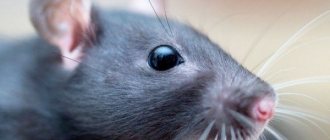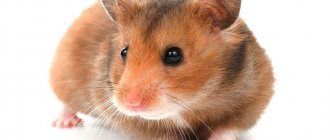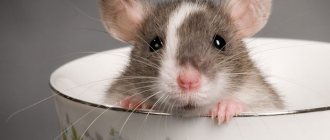Hamsters have always been popular to keep at home, especially when there are children in the house. They are easy to maintain and do not require special care. Among the advantages, we can note the low price, you need little space for keeping, and you don’t have to walk the hamster. Of the minuses it is low hamster lifespan, as well as the presence of an unpleasant odor from the cage when it is rarely cleaned.
On average, hamsters live only 2-3 years; rare individuals can live up to 5 years. A hamster that lives 4 years is considered a long-liver. As is often the case in the animal world, large individuals are able to live slightly longer than their small counterparts.
The lifespan of hamsters depends on several factors:
- species (breed);
- animal size;
- diet;
- conditions of detention;
- animal care;
- physical activity;
- genetics.
What shortens the life of hamsters:
- stress;
- diseases.
In nature, hamsters live somewhat shorter than at home, on average 1.5-2 years. Low life expectancy is associated with lack of food, attacks by predators, unfavorable weather conditions, and diseases. Hamsters often die while still young. It is the baby hamsters that are very vulnerable and are often attacked by predatory animals. Under favorable conditions, a large wild hamster can live up to 5 years.
Such a low life expectancy of hamsters is associated with a fast metabolism and susceptibility to disease and stress. The body of a small animal is not able to resist diseases and the animal often dies.
Life expectancy of different breeds of hamsters at home
Different breeds of hamsters differ greatly from each other. Some people have a strong tendency to certain diseases, while others can boast of good health. For example, hairy-footed hamsters at home live on average 2-3 years, maximum 4. For Siberian hamsters, the upper limit rises to 5 years, but such long-livers are rare.
Syrian
Ornamental Syrian hamsters can live a relatively long life if stress factors are excluded. The indicator reaches 5 years, the average age is 3-4 years. Syrian hamsters are unpretentious. They are easy to care for; your pet’s body is resistant to diseases and pathogens.
Syrian hamsters are easy to care for.
Dzungarian
Djungarian hamsters are more sensitive. Even a small change in the environment can cause them severe stress.
This shortens the pet's lifespan. On average, a Djungarian hamster lives 2-3 years if left undisturbed.
Dwarf
Dwarf hamsters live only 2 years. This breed, like the Dzungarian, is timid and experiences stress at the slightest influence. In order for your pet to live a long life, you need to pay special attention to its nutrition. The animal must receive a full set of nutrients. You cannot pamper your rodent with foods that are harmful to it.
Dwarf hamsters live no more than 2 years.
Siberian
Siberian hamsters are long-lived. Their average lifespan is 3-4 years. However, this breed has a high level of activity, so the animal must be provided with toys. It is advisable to place a couple with your pet. This will reduce your overall stress level.
Reproduction
The breeding season for wild hamsters begins in April and lasts until the end of October.
The female reaches sexual maturity at 3 months. The gestation period is 16 days, so during the summer she manages to bear offspring 2–3 times.
Males show interest in females only during mating, after which they immediately leave her. Often one rodent creates families with several females. The male does not take any part in caring for the offspring.
The average number of cubs is 10 – 18. Babies are born blind and naked. Newborns weigh only 4–6 grams. The cubs develop very quickly. At the age of two weeks, hamsters open their eyes and become covered with fur.
Common field hamster
The feeding period is 20 days, but after 7–10 days the cubs are able to eat solid food. The mother closely monitors the offspring and, in case of danger, moves the cubs to a safe place.
In the wild, rodents are unable to protect themselves from attacks by predators. Natural enemies make it possible to control the population of these animals. Birds of prey, wolves, lynxes, and foxes pose a threat to the field hamster. They may be attacked by cats and dogs in the garden area.
Life cycle of hamsters
At home, hamsters live from 2 to 4 years, sometimes longer. Indicators depend on the conditions of detention. It is more difficult to identify general statistics for animals in the wild.
In the wild
In the wild, hamsters often die while still young. This may be due to the death of the mother, unfavorable environmental conditions, the invasion of a predator, natural disasters, etc. Dangers haunt animals throughout their lives. Hamsters are easily susceptible to overheating and hypothermia. It is believed that severe stress can cause a heart attack in an animal. The hamster may die due to hunger or eat poisoned food.
In the wild, hamsters are haunted by danger.
In the wild, rodents almost never die of old age. Older individuals become slow and weak. They often develop pathologies that interfere with leading an active lifestyle. As a result, old rodents become prey to predators or die from disease.
At home
The most favorable option for a hamster is life in captivity. The owners take care of their pets, carefully select their diet, use safe litter and toys, regularly clean the cage, etc.
In good conditions, the animal's lifespan reaches 4-5 years, but for this it is necessary to reduce the level of stress.
What does lifespan depend on?
The lifespan of a small pet is determined not only by its breed or species. Pet hamsters are very important to care for, as well as proper nutrition.
Care
It is imperative to keep the cage clean. Remains of food that may spoil should be removed daily. For example, fruits or pieces of meat in the heat can slowly rot, which will lead to health problems. Also check corners and piles where your hamster may store food for later.
The bottom of the home must be thoroughly covered with filler. You can purchase corn or cellulose fillers. Your pet needs constant care; every day you need to remove wet litter and insert fresh one. Animals are clean and can relieve themselves in one place. General cleaning and washing of the cage should be done 4 times in 30 days.
You can provide your pet with a playground, labyrinths and tunnels. If the hamster wants to move around the apartment, then it needs to be walked in a walking ball. If there is no walking ball, the hamster may be exposed to danger: it will get stuck somewhere, be pinched by a door, fall, eat poisonous plants, or be able to chew through an electrical wire. Please note that an escaped hamster is very difficult to catch.
You should not leave your animal to walk on high objects such as a table or sofa. Some owners take their hamster for walks in nature, but an animal that was raised at home may be subject to extreme stress or get sick.
If you let your pet go for a walk in nature, then, of course, it will be in danger. There he is in wait for such predators as a dog, a cat, a rat, a crow. The pet will easily run away, but will get lost. The environment is not suitable for a pet, such as wet, grass or hot sun will have a bad effect on the animal.
Nutrition
Your pet needs balanced food that contains vitamins and minerals. Before purchasing, be sure to ask what products should be given to the animal.
You can feed your pet walnuts and peanuts, but you cannot include almonds in the diet, since the skin of the nut may contain harmful elements. It is not forbidden to give many vegetables, except for white cabbage. An additional additive is mineral stone, thanks to which the animal can receive mineral elements. The mineral stone also helps the animal to grind down its incisors.
In general, the main part of the diet is grains. You can purchase special mixtures at a pet store. Expensive formulations also contain vitamins. The pet can eat fruits and vegetables, which need to be cut into small pieces. You can also give a large piece of vegetable so that the hamster can wear down his teeth.
Boiled chicken breast, eggs, insects, low-fat cottage cheese, seeds and nuts are quite suitable for a hamster.
Hamsters should also not be given citrus fruits, potatoes, or exotic fruits.
Diseases
If there is no doctor nearby, then the hamster owner needs to know the symptoms of diseases and their treatment. All processes inside the animal’s body pass quickly, so you need to study in advance the rules that will help your pet if he gets sick.
Diseases can be divided into two types: contagious and non-contagious. There are diseases that have similar symptoms.
First of all, the owner must understand what is happening to the hamster. If the animal is healthy, then it leads an active lifestyle and eats well. In healthy pets, the coat should be dry, thick, shiny and smooth, and the eyes should be clear and clean.
A sick hamster has the following symptoms:
- appetite is impaired: the hamster completely or partially refuses food, selectively eats food, and his thirst increases;
- saliva flows profusely – there is wet fur on the chin, neck, chest;
- the animal has diarrhea - the back half of the body has wet fur or traces of feces;
- in addition to diarrhea, there may also be constipation - the stool is dry and hard or absent altogether;
- the eyes become watery or discharge pus;
- breathing is difficult, mucus and wheezing are released from the nostrils;
- there are problems with the skin: the coat is dull in color, flaky, has bald spots, wounds;
- the hamster becomes lethargic, moves little, lies constantly;
- the nervous system deteriorates - coordination is impaired or convulsions appear;
- the body becomes swollen.
If there is any disturbance in the pet’s routine, this will be a reason for concern and examination of the animal.
Optimal age of a rodent to purchase
The best age for a hamster to move into a home is 3-4 weeks. Younger individuals most often die: rodents should not be separated from their mother too early. It is not recommended to purchase animals older than 3-4 weeks. At 1.5-2 months, females begin to reproduce, so if they are kept together in cramped conditions with males, there is a high probability of buying a pregnant individual. Even if you find future owners of the offspring, early birth will adversely affect the health of the animal and shorten its lifespan.
It is not recommended to purchase individuals older than 4 months, especially when the conditions under which they are kept are unknown. If you haven’t communicated with your pet, you won’t be able to train it. For the rest of its life, the hamster will experience stress when in contact with humans, which will negatively affect the animal’s lifespan. Another problem is the rapid development of diseases under poor living conditions. There is a high probability of acquiring an unhealthy individual.
How to find out the age of a hamster
In pet stores and markets, the age of a hamster is determined by weighing it. However, this method is inaccurate. Some individuals grow faster than others. Averages may vary depending on breed.
The age of a hamster is determined by its weight.
When purchasing, it is recommended to pay attention to the behavior of the animal. Young individuals are more active, they run and play, make sounds, and eat often, but little by little. Adult animals behave calmer. They are inactive, sleep more often, and eat rarely. In newborn rodents, the inside of the ear cavity is covered with white soft down. As you get older, the hairs thin out. In older individuals, there is no down inside the ears.
Young hamsters have eyes of the same color. They are slightly moist and shiny, and do not protrude much from the eye sockets. The appearance of cloudiness in the eyes indicates that the rodent is elderly.
When determining age, you can focus on the quality of your pet's coat. The thicker and tougher it is, the older the hamster. Young individuals have a rich, bright coat without bald patches. Newborn animals have soft fluff.
Coarse hair appears only at 2-2.5 weeks. The more pigment spots on the skin, the older the animal.
What to look for when buying a rodent
First of all, when purchasing a rodent, you need to inspect the living conditions. The cages must be clean. Cramped contents are not allowed. Sometimes sellers offer discounts on individual individuals. Most often, old, wounded or sick animals are given away at half price. You cannot agree to such a deal, because as a result you will either spend more money than you saved on treating your pet, or the hamster will die.
Behavior and activity
A healthy young animal behaves actively. It squeaks, constantly searches for food and plays. However, during the day the pet is less active, since hamsters are nocturnal. It is better to assess the behavior of rodents in the evening.
Healthy hamsters are constantly looking for food.
Eyes and coat condition
A healthy pet's eyes are clean, slightly moist, shiny, without discharge. There are no stains on the surface. The eyes should not protrude too far forward.
The fur of young hamsters is soft and not very thick. A hard, dense coat is present in older pets.
It is unacceptable to have bald spots or redness on the skin. The wool should not be wet.
Where is the best place to buy a hamster?
You can buy an animal from friends, at a pet store or at the market. All options have their advantages and disadvantages.
In the case of acquaintances, conditions of detention are often better. Professional breeders remove animals from each other in a timely manner, properly care for them, and provide them with high-quality food. Additionally, friends can give advice on content. The disadvantages include a small selection of animals.
A pet store is a mixed bag. The permissibility of purchasing a rodent in such an establishment depends on the conditions under which the animals are kept. If all the cages are clean, the pets have fresh water and food, and there are no sick animals, then the pet store is trustworthy. Otherwise, it is better to visit another establishment. Animals should not fight with each other. The presence of an unpleasant odor is unacceptable.
It is better to buy a hamster at a pet store.
The advantages of pet stores include a wide selection. Often establishments keep hamsters of not only different colors, but also breeds. If the pet store is good, it carries out veterinary control.
The disadvantage of this option is overcrowding of cells. Hamsters are kept in close quarters. Because of this, animals can get injured, get sick, become infected, become pregnant early, etc. In pet stores, rodents have almost no contact with people, so they will have to be tamed.
Spontaneous markets are not a desirable option. In most cases, sales are carried out by resellers who keep so many animals in one cage that they can barely fit. Since these are rodents from different places and from different parents, in such cramped conditions there is a high probability of infection of all individuals. Animals often fight due to stress and lack of territory.
The disadvantages of markets include the high probability of purchasing an unhealthy or old pet. The advantage is a wide selection of hamsters. The market sells pets of different breeds, colors and ages.
Resellers try to purchase recently born rodents, so the animal will be easier to tame.
Answers to popular questions
Before getting their first hamster, people ask many questions. We have collected the most popular of them and will try to provide brief information.
What breed of hamster is best to buy for a child?
Several factors need to be taken into account: the age of the child, how many hamsters you plan to buy, whether you can look after him and devote a lot of time.
Let's say the only hamsters that can respond to a name are Syrian ones. Djungarians live only one at a time. Campbell's are more social, they need a friend so they don't get bored.
Hamster and baby
Males of any hamsters, as a rule, are larger than females, but more “fragrant” because they mark their territory, i.e. You need to clean the cage more often. Are you and your child ready for this? You should not completely entrust the maintenance of the animal to the child; be sure to control the processes.
What factors shorten the lifespan of hamsters?
The following factors are unfavorable for rodents:
- stress;
- cramped living conditions;
- frequent bathing;
- excessive attention;
- poor quality food and water;
- rare feedings, etc.
Hamsters should not be bathed frequently.
Any unfavorable factors shorten the life of the pet. They can provoke the development of pathologies and lead to the early death of the hamster. For example, drinking stale water can lead to infection or poisoning.
Frequent bathing
Hamsters are not among the animals that take water calmly. For small pets, liquid is a potential source of danger. For this reason, the hamster perceives every bath as a threat to life, an attempt to drown it. This causes severe stress and shortens life expectancy. In rare cases, discomfort from the process can cause death.
It is not advisable to bathe hamsters in water. The pet gets rid of dirt on its own. As a last resort, some breeds may benefit from sand baths. If the dirt is extensive, you can clean the wool with a special brush. Bathing is carried out only when there is no choice.
Stress
Under the influence of stress, a hamster's internal organs wear out faster. In some cases, this condition leads to death. After a strong shock, the pet may become lethargic, refuse food and water, begin to hide and become exhausted.
Stressing a hamster can lead to its death.
Stress occurs for various reasons. For example, single people do not like it when neighbors move in with them. Hamsters, who prefer large groups, on the contrary, yearn without individuals of their own species. Even a child can cause stress to a pet if he constantly tries to play with the rodent. Too bright light, loud sounds, etc. can cause discomfort.
Presence of diseases
Hamsters sometimes develop chronic pathologies. Additionally, rodents are susceptible to infectious diseases. An animal can become infected, for example, with tuberculosis, plague or tularemia. Signs of infection include trembling, aggressive behavior, increased breathing, discharge from the eyes or nose, loss of fur, etc.
Improper care
Improper care can cause a significant reduction in the life of a pet and its death. For example, animals fall out of hands and are injured if handled carelessly.
Why did wild hamsters appear in the country? How to get rid of it?
With the onset of summer, wild hamsters often take up residence in gardens and vegetable gardens. This is due to the ripening of the crop and the beginning of the harvesting season for animals.
Rodents cause enormous harm to homestead farms. The large number of wild hamsters and the ability to adapt to any conditions allows them to quickly develop territory, and the ability to build complex burrows makes them difficult to destroy.
The presence of a hamster in the garden can be guessed by the following signs:
- tunnels and exits from holes. In the hamster they are wider than in moles and shrews;
- damaged bark in the lower part of fruit trees, since animals like to gnaw the bark at the very bottom, near the roots;
- digging in carrot beds and near potato bushes;
- the presence of characteristic small marks.
Common hamster
Currently, farmers and summer residents use different ways to deal with uninvited guests.
- Flooding holes. To do this, close all exits from the hole and pour water until the hamster crawls out. If not all emergency passages are closed, the animal can get out and run away.
- Digging holes and catching by hand. Very labor-intensive and dangerous.
- Use of traps and snares. The devices are effective, but it is very difficult to track where to install them
- Poisoned baits. Rat and mouse poisons are most often used. The disadvantage of use is the destruction of a small number of pests. Domestic cats and dogs may also be affected.
- Use of noise and ultrasonic repellers. Quite a costly method. Also, protecting a large area will require a significant number of devices.
How to increase your pet's lifespan
To prevent the early death of your pet, you need to provide it with high-quality nutrition. It is necessary to provide the animal with the opportunity to lead an active lifestyle. To reduce the risk of infection, you need to remove the cage in a timely manner. If you want to give your pet walks, they must be safe for his life.
Proper nutrition
Most types of food common to humans are contraindicated for a hamster. Pets are offered grains and legumes. The menu includes nuts, peanuts, dried fruits and berries. Crickets in small quantities are suitable as a source of protein. Vegetables include pumpkin, cucumbers, zucchini and carrots. Rodents are offered plantain leaves, dandelion leaves, and carrot tops as treats. Hamsters happily eat hay and greens.
You can give your hamster a variety of nuts.
Large cage and timely cleaning
The minimum cage size for 1 individual is 30x30x45 cm. Too small will cause stress in the animal. Overpopulation is also a danger. Even in a spacious cage, animals should not be kept in large groups. This may not suit their natural habits.
The cage should have space for a toilet, toys, food and water bowls. You cannot use an aquarium as a home. If there is insufficient ventilation, your pet will have breathing problems. Cages with a plastic monolithic bottom and metal rods are better suited for keeping pets.
Cleaning is carried out 2 times a week. At this time, the pet is placed in a spare cage so that it does not escape. No chemicals are used for cleaning. As a last resort, in case of severe contamination, use baby soap or shampoo for hamsters.
Games and activities
Pets experience stress when they do not have the opportunity to expend excess energy. To prevent deterioration in health, it is recommended to place a wheel in the cage. You can purchase a special transparent ball: it will allow your pet to safely walk around the house.
What does it eat in nature?
The rodent is omnivorous. He has a good appetite. The main diet consists of plant foods, but in spring and summer it will not refuse insect larvae, small reptiles, crustaceans and mollusks.
With the onset of autumn, the animal consumes more plant foods. At this time, the hamster's harvesting season begins. The field hamster's diet is based on corn, peas, grains of wheat, buckwheat, millet, potatoes and carrots, the reserves of which he stores in pantries.
Wild hamster - carbysh
The rodent creates supplies thanks to its cheek pouches, which it uses to carry food. One bag holds up to 50 g of grain, which the animal can carry over a distance of more than a kilometer, supporting the bags with its front paws.
Wild hamsters store large amounts of food in their burrow. Burrows with huge reserves were discovered, hundreds of times exceeding the rodent's own weight.
Karbysh eat food while sitting on its hind legs. He eats by holding the food with his front paws and stuffing the food into one cheek, then the other, then quickly chews it.











